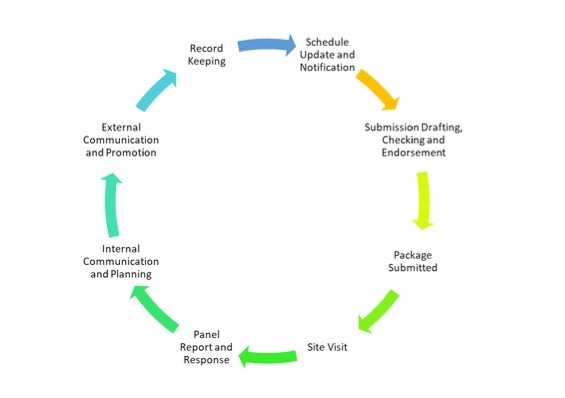Professional accreditation
Many courses at Flinders are externally accredited by professional bodies. Quality assurance by external agencies is an important element of a robust quality assurance framework.
It ensures that students are receiving the most up to date and professionally relevant content in their course and will graduate with necessary skills and competencies.
Your guide to accreditation submission
Purpose of Accreditation
- To support and facilitate continuous improvement, risk management and evidence based decision making.
- To signal quality, reliability and/or comparability to others.
- To demonstrate achievement of standards and measurements set by external agents, and once achieved the ongoing maintenance of those standards and measurements.
Underpinning Principles
Continuous Improvement: Ongoing reflective feedback involving monitoring, review and consequent evidence-based improvement
Quality Improvement Loop: A cycle of action, feedback and evidence, analysis, planning which includes experimentation
Feedback Loop: Seeking and reviewing feedback and evidence from multiple different relevant sources to determine progress, achievement, strengths, challenges and improvements
Benchmarking: Internal practice, policy, activities, inputs and/or outputs compared to external others to evaluate progress, towards and/or achievement of standards
Evidence-based Decisions: Decisions to act or not, and/or what actions to take, grounded in a critical analysis of sufficient, relevant, reliable, valid, current evidence
Participants
Decision Makers: Ultimately accountable for the outputs and impact of the quality assurance process
Planners and Actors: Operationalise and implement the decision makers’ decisions
Analysts: Evaluate, interpret and analyse the data to inform decisions
Data Gatherers: Source and collect data and information to be analysed
Reporters: Communicate the quality assurance processes, inputs, outputs and outcomes
Enablers and Supporters: Provide advice, information, actions and/or resources that enable the quality assurance process to be undertaken
Quality Assurance Process
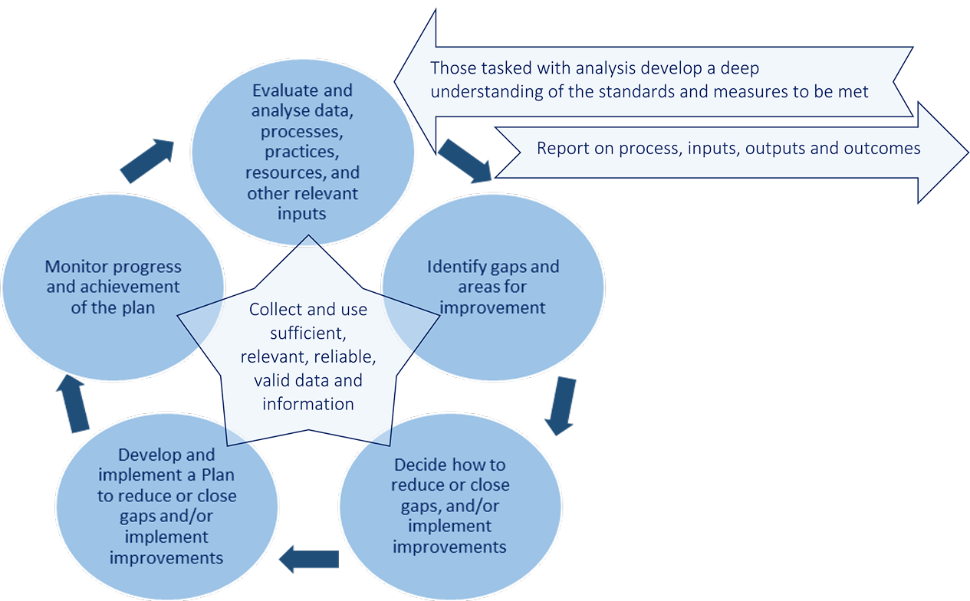
References:
Academic Quality Assurance https://www.teqsa.gov.au/latest-news/publications/guidance-note-academic-quality-assurance
Association to Advance Collegiate Schools of Business (AACSB) https://www.aacsb.edu/about
Owlia, Mohammad S. & Aspinwall, Elaine M. (1996) "A framework for the dimensions of quality in higher education", Quality Assurance in Education, Vol. 4 Issue: 2, pp.12-20, https://doi.org/10.1108/09684889610116012
Accrediting bodies differ in the support they provide for accreditation processes. Some accrediting bodies come equipped with detailed templates and comprehensive instructions for institutions to follow, while others provide more general guidelines. Regardless of the expectations of the accrediting body, there are some common steps that can be taken in the approach to leading an accreditation process:
- Nominate an academic lead to drive the project.
- Set up OneDrive folders for:
- Draft submission
- Accrediting body documents
- Project group documents
- Standard 1 evidence
- Standard 2 evidence
- Etc…
- Follow Office 365 Group Management Guidelines and naming conventions for documentation.
- Read the standards carefully to ascertain what is required.
- Delegate sections of evidence collation to relevant “expert” areas, eg Topic coordinators, course coordinators, Planning and Analytical Services with clear timelines for return of information. For Certificates of Insurance use Service One to send a request to Risk & Insurance.
- Maintain ownership over the Master Draft Submission to ensure changes are tracked and monitored and a consistent language is maintained throughout.
- If using FLO for storing and ultimately distributing materials to the accrediting panel, an important step in the process is contacting the Director of College Services to sponsor and obtain temporary FAN accounts for visiting panel members. Refer to the AccessNow page for instructions to set up FANs for the visiting panel.
- When you’re not preparing a submission, get involved with activities for the relevant accrediting authority. You can learn a lot from being an accreditor of other programs and it helps to see it “from the other side” when you are preparing accreditation submissions.
"This report by its very length, defends itself against the risk of being read." – Winston Churchill
Writing accreditation documents is unlike other forms of writing. The author is tasked with evidencing claims and addressing strict standards while at the same time telling the story of the degree or program being accredited in an engaging and persuasive way. The language of the documents is vital to ensure that the required audience – the accrediting panel – can easily interpret the message and receive the information they need to compile their report.
Here are four tips to help the budding accreditation lead:
1. Keep the reader in mind
The documents will be read by a panel of external accreditors who will likely have in depth understanding of the standards and requirements needed for accreditation. They will be looking for evidence and gaps but won’t have a lot of time at their disposal. Avoid overwhelming the panel with too much information and verbiage.
“writing is more likely to be persuasive if it is not pompous, unnecessarily complicated, or loaded with technical jargon… If a word, idea, or sentence does not contribute directly to the point, consider eliminating it.” (Chambers, 2018)
2. Consider the evidence
Think reflectively about what the evidence means and interpret it for the panel. If the evidence doesn’t speak to the criteria being addressed in an obvious way, contextualise it for the panel. If the evidence doesn’t make sense, isn’t clear, or isn’t accurate, don’t include it. Inaccurately evidencing the criteria suggests a deviation from the Standards, and this is not something you want to do! It is important to present evidence that is relevant, valid, reliable, and representative of the underlying situation. In some instances, multiple sources or methods should be employed. Importantly, the “entire body of evidence should be mutually reinforcing” (WASC, 2015). More evidence is not necessarily better – it depends on what it is.
“A structured and well-explained presentation, anchored on a succinct body of well-documented and reflected-upon evidence, will be far more convincing than simply a “data dump.”” (WASC, 2015)
3. Answer the question
What exactly is the criterion asking? If it is asking for Terms of Reference of a Review Committee, supply the Terms of Reference. If you don’t have a Review Committee, but some other form of committee to oversee the course, explain this in the submission document and supply the Terms of Reference of that committee. If the criterion is asking you to show engagement with a group that you have not engaged with before, explain this and note that it is an area that requires improvement. Acknowledging failure to evidence criteria but willingness to improve is always better than ignoring or avoiding criteria.
4. Work as a team
Accreditation should be a team effort. It is not a task to be performed by one person in isolation. It requires input from people with different expertise, experiences and viewpoints. An important early step in the accreditation process is therefore establishing who will be working on the project. Within this, clear lines of communication need to be established together with document management protocols. It is sensible for one person to manage the master draft, distributing sections out for input from other areas as necessary, before incorporating contributions back into the master draft. In this way, an accreditation document is a “live” document, with the source held by one master. A team approach to compiling evidence and telling the “story” of the course will ultimately benefit the entire group in terms of their own understanding of the course and its broader context. It will also help to create a cohesive and collaborative environment which will be evident for any visiting accreditors.
"a successful visit with accreditation awarded will only be achieved when faculty, staff, administrators, and students work collaboratively to support and collect the evidence needed (Head & Johnson, 2011). Accreditation can be the driving force behind a push to demonstrate institutional effectiveness (Head & Johnson, 2011)." (Hail et al, 2019)
References
Chambers, Richard (2018). Writing an Impactful Audit Report: 6 Tips for Being More Persuasive. Internal Auditor
Hail, C., Hurst, B., Chang, C. W., & Cooper, W. (2019). Accreditation in Education: One Institution's Examination of Faculty Perceptions. Critical Questions in Education, 10(1).
WASC Senior College & University Commission (2015). Using Evidence in the WSCUC Accreditation Process Guide.
The following exemplars show how FLO sites and Microsoft Teams and SharePoint can be used to house accreditation documentation.
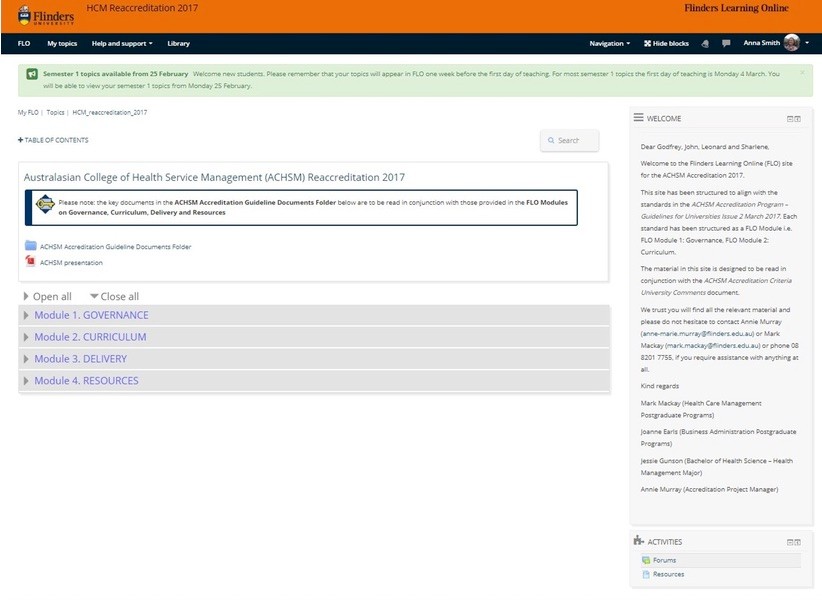
Credit: ACHSM Accreditation 2017 Team - Professor Mark Mackay, Joanne Earls, Dr Jessie Gunson, Dr Annie Murray (Accreditation Project Manager).
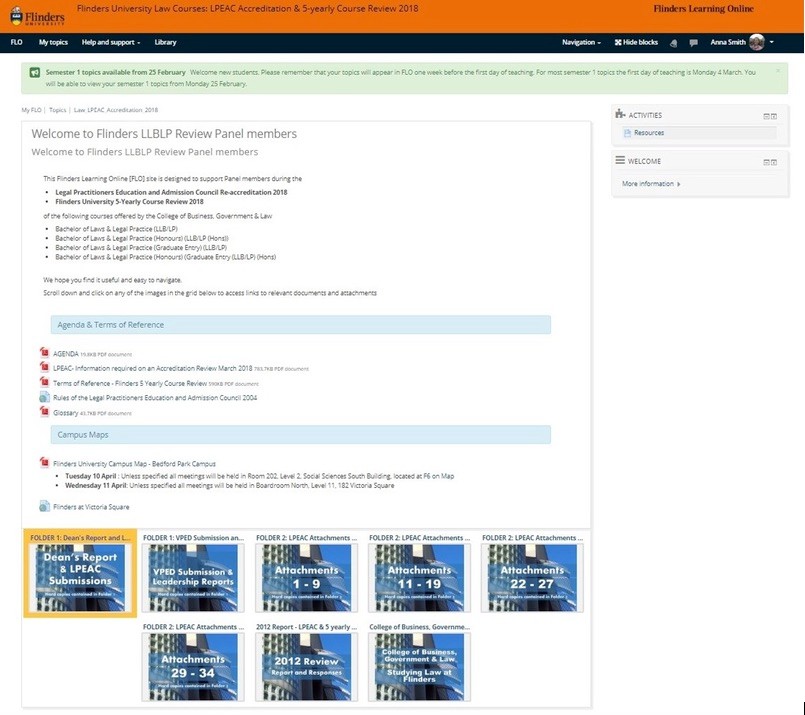
Credit: LPEAC Accreditation 2018 Team - Associate Professor Tania Leiman and Ms Melissa Huish.

Mock up of Microsoft Teams accreditation site.
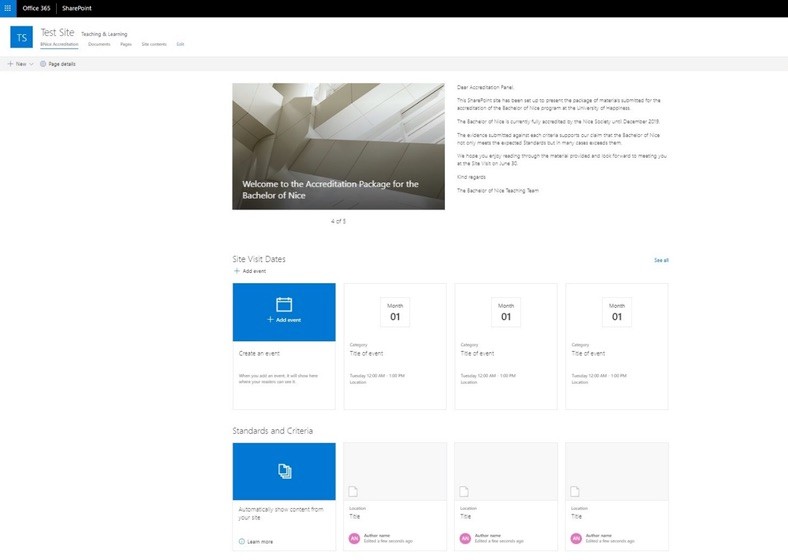
Mock up of SharePoint accreditation site.
Accrediting bodies
We are currently negotiating new accreditations.
Australian Counselling Association (ACA)
Australian Medical Council (AMC)
Australian Health Practitioner Regulation Agency (AHPRA)
Australian Institute of Medical and Clinical Scientists (AIMS)
Psychotherapy and Counselling Federation of Australia (PACFA)
Australian Diabetes Educators Association (ADEA)
Australian Nursing and Midwifery Accreditation Council (ANMAC)
Australian Physiotherapy Council
Dietitian's Association of Australia
Exercise and Sports Science Australia (ESSA)
Occupational Therapy Council (Australia and New Zealand)
Optometry Council of Australia and New Zealand (OCANZ)
Rehabilitation Counselling Association of Australasia (RCAA)
Useful links
Curriculum links
Governance documents and links
-
TEQSA Registration of Flinders
Quality Indicators for Learning and Teaching Data
University organisational structure
University council and committees
College organisational structure
Flinders University annual report and financial statements
Assessment Policy
Courses Policy
Strategic Plan
Library support for accreditation via Service One
![]()
Sturt Rd, Bedford Park
South Australia 5042
CRICOS Provider: 00114A TEQSA Provider ID: PRV12097 TEQSA category: Australian University
